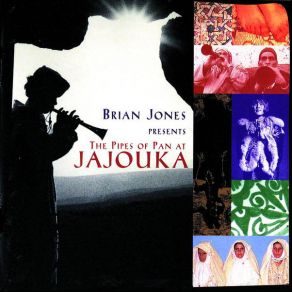Brian Jones Presents the Pipes of Pan At Jajouka
Download links and information about Brian Jones Presents the Pipes of Pan At Jajouka by The Master Musicians Of Jajouka. This album was released in 1971 and it belongs to World Music genres. It contains 6 tracks with total duration of 45:58 minutes.

|
|
|---|---|
| Artist: | The Master Musicians Of Jajouka |
| Release date: | 1971 |
| Genre: | World Music |
| Tracks: | 6 |
| Duration: | 45:58 |
| Buy it NOW at: | |
| Buy on iTunes $9.99 | |
Tracks
[Edit]| No. | Title | Length |
|---|---|---|
| 1. | 55 (Hamsa oua Hamsine) | 0:58 |
| 2. | War Song / Standing & One Half (Kaim Oua Nos) | 2:22 |
| 3. | Take Me With You My Darling, Take Me With You (Dinimaak a Habibi-Dinimaak) | 8:05 |
| 4. | Your Eyes Are Like a Cup of Tea (Al Yunic Sharbouni Ate) | 10:34 |
| 5. | I Am Calling Out (L'Afta) | 5:54 |
| 6. | Your Eyes Are Like a Cup of Tea (Reprise with Flute) | 18:05 |
Details
[Edit]In 1968 Brian Jones of the Rolling Stones traveled to Morocco and taped parts of music at the Rites of Pan Festival. It's uncertain whether this should be considered a Brian Jones album, or an album by the Pipes of Pan at Jajouka, or an album by the Master Musicians of Jajouka, as the performers on this recording are most commonly known in the West. The important thing to know is that it's a document of Moroccan traditional music that achieves trance-like effects through its hypnotic, insistent percussion, eerie vocal chanting, and pipes. Originally divided into two untitled, unbroken LP sides (although these are broken down and officially titled on the CD reissue), it should be kept in mind that these are merely edited excerpts of performances which can last for hours, and thus they offer only a taste of the live event. Although the first part in particular builds and builds in relentless energy to whirling climaxes, there are discrete and different performances here, some featuring female chants, others less intense male vocals, and others passages of unaccompanied instruments which sound like flutes (credits and details on the original release are sparse). While this music had been performed in this fashion for a long time before Jones documented it, this was among the first of such recordings to receive reasonably wide exposure (although it was released after Jones' death) in Europe and North America. Thus this recording anticipated the wider popularity of trance-like music among both electronic rock and progressive African musicians later in the 20th century.